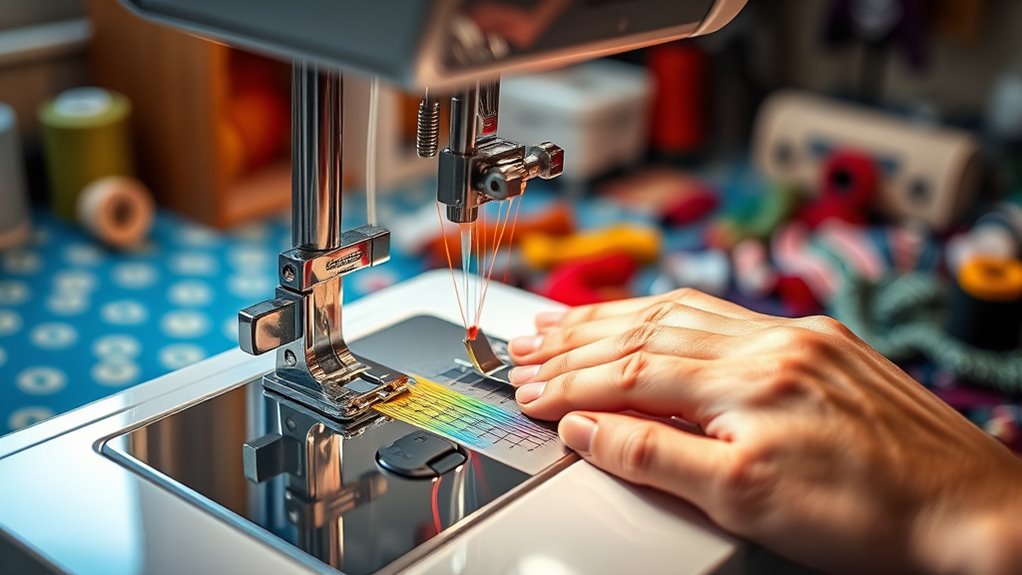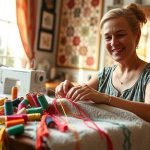Sewing machines can be easy to use once you grasp their basics. Mechanical models are typically user-friendly for beginners, while computerized machines offer advanced features, though they may require more maintenance. You’ll find that intuitive controls and built-in tutorials enhance your experience. However, you might face challenges with threading and maintaining tension. Familiarizing yourself with your machine’s components and exploring simple projects will improve your confidence. There’s plenty more to explore that can boost your sewing skills.
Understanding the Basics of Sewing Machines
Sewing machines, the backbone of modern textile crafting, might seem intimidating at first glance, but understanding their fundamentals can demystify the process. You’ll encounter various sewing machine types, including mechanical, electronic, and sergers, each designed for specific tasks. Familiarizing yourself with these options is vital.
For instance, mechanical machines are user-friendly for beginners, while electronic machines offer advanced features for intricate designs. Fabric compatibility is another essential aspect; not all machines can handle every fabric type.
For example, lightweight materials like silk require a different needle and tension setting compared to heavier fabrics like denim. By grasping these basics, you’ll feel more confident in selecting the right machine and fabric for your projects, leading to greater satisfaction in your crafting endeavors.
Key Features That Enhance User-Friendliness
When choosing a sewing machine, look for intuitive controls and settings that simplify operation. Features like built-in tutorials and guides can greatly enhance your learning curve, allowing you to master techniques quickly. These elements work together to create a user-friendly experience, making sewing more enjoyable and efficient.
Intuitive Controls and Settings
A user-friendly sewing machine often features intuitive controls and settings that simplify the sewing process, making it accessible even for beginners. You’ll find user-friendly interfaces, such as touchscreens or clearly labeled dials, that allow for quick navigation through various functions.
These interfaces enable you to select stitch types, adjust tension, and set the stitch length with ease. Additionally, many machines offer adjustable settings, allowing you to customize your sewing experience based on fabric type and project requirements.
For instance, you can tweak the speed control to suit your comfort level, ensuring a smoother sewing journey. With these intuitive features, you’ll feel more confident and capable, enhancing both your skills and enjoyment of sewing.
Built-in Tutorials and Guides
How can built-in tutorials and guides transform your sewing experience? These features make it easier for you to navigate various functions and techniques. With interactive tutorials, you can follow step-by-step instructions tailored to your specific project, ensuring you develop your skills with confidence.
Built-in demonstrations often include visual aids, which can clarify complex processes, like threading or bobbin installation. When you encounter challenges, these guides provide immediate support, reducing frustration and enhancing learning.
They’re especially beneficial for beginners, as they demystify the operation of your sewing machine. By integrating these resources into your practice, you’ll build a solid foundation, empowering you to tackle more advanced projects with ease and precision. Embrace these tools and elevate your sewing journey!
Comparing Manual vs. Computerized Sewing Machines
Which type of sewing machine suits your needs better: a manual or a computerized model? Manual sewing machines offer several advantages, including simplicity and reliability. They’re often more durable and easier to maintain since they lack complex electronic components.
If you’re looking for straightforward functionality, a manual machine might be your best bet. However, computerized sewing machines come with advanced features, like automatic stitch selection and built-in tutorials, making them user-friendly. Yet, they do have drawbacks, such as being more expensive and requiring more maintenance.
If you enjoy experimenting with various stitches and patterns, a computerized model could be worth the investment. Ultimately, your choice should depend on your sewing style and the features you value most.
Common Challenges for Beginners
As a beginner, you’ll likely encounter several challenges when using a sewing machine, such as threading the machine correctly and understanding the various stitch types available. It’s essential to maintain consistent tension, as this directly impacts the quality of your stitches. By addressing these common issues, you can improve your sewing skills and enjoy a more seamless experience.
Threading the Machine
While threading a sewing machine may seem straightforward, many beginners encounter common challenges that can lead to frustration. One frequent issue is selecting the right thread type; for example, using a heavier thread in a lightweight fabric can cause tension problems.
Make certain you’re using the appropriate threading techniques for your specific machine model, as each machine may have different threading paths. Always begin by raising the presser foot to help the thread slip into the tension discs easily.
Don’t forget to check the bobbin placement; it must unwind in the correct direction to prevent jamming. Finally, if you’re experiencing skipped stitches, re-examine your threading process, as improper threading can drastically affect performance.
Understanding Stitch Types
Understanding stitch types is essential for anyone looking to master sewing, since each type serves a specific purpose and can affect the overall quality of your project. You’ll encounter various stitches like straight, zigzag, and decorative, each requiring careful stitch selection based on your fabric and design.
For instance, a straight stitch is best for seams, while a zigzag stitch offers flexibility for knits. Pay attention to stitch width as well; it can greatly change the fabric’s drape and finish. Adjusting the stitch width on your machine allows you to customize the appearance and strength of your seams. Familiarizing yourself with these elements will help you avoid common pitfalls and improve your sewing skills considerably.
Maintaining Consistent Tension
Selecting the right stitch type can elevate your sewing project, but even the best stitches won’t shine if your thread tension isn’t consistent. To maintain proper tension, regularly check the tension settings on your sewing machine. If you notice puckering or loose stitches, it’s time for some tension troubleshooting.
Begin by making small tension adjustments; turning the dial slightly can greatly impact your results. Always test on a scrap fabric before proceeding with your main project. If the upper thread is too tight, loosen it; if it’s too loose, tighten it. Consistency is key, so keep an eye on both the upper and bobbin tensions to guarantee they work harmoniously. With practice, mastering tension will become second nature.
Tips for Getting Started With Your Sewing Machine
Getting started with your sewing machine may seem intimidating at first, but with a few essential tips, you’ll quickly gain confidence and skill. Familiarize yourself with your machine’s components, including the foot pedal, needle, and bobbin.
Always use the right sewing machine accessories, like the appropriate needle and presser foot for your fabric type. Start with beginner sewing projects, such as simple pillowcases or tote bags, to practice your skills.
Make sure to thread your machine correctly and adjust the tension as needed. Practice sewing straight lines and curves on scrap fabric to improve your technique. Finally, don’t hesitate to consult your machine’s manual for specific instructions or troubleshooting tips, ensuring a smoother sewing experience.
Resources for Learning and Improving Sewing Skills
Once you’ve gained some confidence with your sewing machine, exploring various resources can help you further enhance your skills. Here are some effective options:
- Sewing Classes: Local fabric stores or community centers often offer classes tailored to different skill levels, providing hands-on guidance.
- Online Tutorials: YouTube and dedicated sewing websites host countless tutorials that cover specific techniques and projects.
- Sewing Blogs: Follow experienced sewists who share tips, patterns, and troubleshooting advice, enriching your understanding.
- Books and Magazines: Invest in instructional books or subscribe to sewing magazines for in-depth techniques and inspiring projects.
Utilizing these resources will not only improve your skills but also keep you motivated and engaged in your sewing journey.
Frequently Asked Questions
Can I Use a Sewing Machine Without Prior Experience?
Yes, you can use a sewing machine without prior experience. Start with basic sewing machine types, and follow beginner sewing tips like threading correctly and practicing simple stitches to build your confidence and skills.
How Long Does It Take to Learn Sewing Machine Basics?
It usually takes a few hours to grasp sewing machine basics, but mastering sewing machine techniques may require a couple of weeks. Expect a learning curve as you practice threading, stitching, and adjusting settings.
Are There Specific Brands Recommended for Beginners?
Many beginners find brands like Brother and Janome ideal due to their user-friendly features. In fact, over 70% of novice sewists prefer these for their reliable brand comparisons and accessible beginner features, ensuring a smoother learning experience.
What Maintenance Do Sewing Machines Require?
To maintain your sewing machine, regularly clean it using a soft brush and lint cloth. Lubricate moving parts with the recommended oil to guarantee smooth operation, following the manufacturer’s guidelines for specific cleaning techniques and lubrication methods.
Can I Sew Different Fabrics With One Machine?
Yes, you can sew different fabrics with one machine. Just guarantee your machine’s needle and settings match the fabric compatibility. Using appropriate sewing techniques will help achieve clean seams across various materials, like cotton, silk, or denim.


